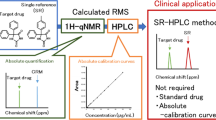Abstract
Benzene is a highly toxic solvent that should be limited to no more than 2 ppm in drug substances, as regulated by the International Council for Harmonization guideline Q3C. We herein report an assay method for residual benzene detection in the delgocitinib drug substance using conventional high-performance liquid chromatography (HPLC). The proposed method takes advantage of the good extraction efficiency of benzene when using non-polar organic solvents, the ability of benzene to concentrate in minimum amounts of organic solvent, and the high solubility of the delgocitinib drug substance in aqueous media, resulting in salt formation as well as excellent sensitivity and selectivity. Specifically, this method uses 5 mL of 8 mol/L potassium hydroxide as an aqueous medium and 1 mL of n-hexane as organic solvent, in order to increase the resolution and sensitivity to residual benzene for HPLC. Range of the method was from 0.5 to 3 ppm according to the results of linearity, accuracy and precision, and limits of detection and quantitation of the method were 0.1 and 0.5 ppm, respectively. We expect this method to be used as a general and convenient assay of excellent sensitivity and selectivity for benzene detection, particularly when contained in water-soluble drug substances.






Similar content being viewed by others
References
Agency for Toxic Substances and Disease Registry (ATSDR) (2007) Toxicological profile for benzene. p 438
Amano W, Nakajima S, Kunugi H, Numata Y, Kitoh A, Egawa G, Dainichi T, Honda T, Otsuka A, Kimoto Y, Yamamoto Y, Tanimoto A, Matsushita M, Miyachi Y, Kabashima K (2015) The Janus kinase inhibitor JTE-052 improves skin barrier function through suppressing signal transducer and activator of transcription 3 signaling. J Allergy Clin Immunol 136(3):667–677. https://doi.org/10.1016/j.jaci.2015.03.051
Amano W, Nakajima S, Yamamoto Y, Tanimoto A, Matsushita M, Miyachi Y, Kabashima K (2016) JAK inhibitor JTE-052 regulates contact hypersensitivity by downmodulating T cell activation and differentiation. J Dermatol Sci 84(3):258–265. https://doi.org/10.1016/j.jdermsci.2016.09.007
Berg L (1990) Separation of benzene from acetone by azeotropic distillation. US Patent 4,931,145, 5 June 1990
Budavari S (1996) The Merck Index: an encyclopedia of chemicals, drugs and biologicals, 12th edn. Merck and Co., Inc., Rahway
Djavanshir D, Abolghasem J, Jamal N (2008) Ultrasonic assisted SPME coupled with GC and GC–MS using pencil lead as a fiber for monitoring the organic volatile impurities of ceftazidime. J Chromatogr Sci 46(8):680–685. https://doi.org/10.1093/chromsci/46.8.680
European Pharmacopoeia (EP) Ed 9.6 (2018) General Chapter 2.4.24. Identification and control of residual solvents. Strasbourg, France, Council of Europe
International Agency for Research on Cancer (IARC) (2012) Monograph 100F, pp 249–294
International Conference on Harmonization (ICH) of Technical Requirements for Registration of Pharmaceuticals for Human Use, Topic M7 (R1) (2017) Assessment and control of DNA reactive (mutagenic) impurities in pharmaceuticals to limit potential carcinogenic risk
International Conference on Harmonization (ICH) of Technical Requirements for Registration of Pharmaceuticals for Human Use, Topic Q2A and Q2B (R6) (2005) Guideline on validation of analytical procedures
International Conference on Harmonization (ICH) of Technical Requirements for Registration of Pharmaceuticals for Human Use, Topic Q3C (R6) (2016) Guideline for residual solvents
Jörg F, Ulrich G, Thomas AS (2005) Toluene in Ullmann’s encyclopedia of industrial chemistry. Wiley-VCH, Weinheim
Katharina S, Ulrich O, Thomas B, Werner W (2013) Changes in recovery due to drug product matrix ageing as a source of mass imbalances. J Pharm Biomed Anal 74(23):117–125. https://doi.org/10.1016/j.jpba.2012.10.014
Nakagawa H, Nemoto O, Igarashi A, Nagata T (2017) Efficacy and safety of topical JTE-052, a Janus kinase inhibitor, in Japanese adult patients with moderate-to-severe atopic dermatitis: a phase II, multicentre, randomized, vehicle-controlled clinical study. Br J Dermatol 178(2):424–432. https://doi.org/10.1111/bjd.16014
Paul SC, Walters WP (2014) Acidic and basic drugs in medicinal chemistry: a perspective. J Med Chem 57(23):9701–9717. https://doi.org/10.1021/jm501000a
Santosh K, Neetu S, Ram P (2010) Anhydrous ethanol: a renewable source of energy. Renew Sustain Energy Rev 14(7):1830–1844. https://doi.org/10.1016/j.rser.2010.03.015
Sebrina W (2012) Basic technology and tools in chemical engineering field. World Technologies, Amsterdam
Tanimoto A, Ogawa Y, Oki C, Kimoto Y, Nozawa K, Amano W, Noji S, Shiozaki M, Matsuo A, Shinozaki Y, Matsushita M (2015) Pharmacological properties of JTE-052: a novel potent JAK inhibitor that suppresses various inflammatory responses in vitro and in vivo. Inflamm Res 64(1):41–51. https://doi.org/10.1007/s00011-014-0782-9
Tanimoto A, Shinozaki Y, Yamamoto Y, Katsuda Y, Taniai-Riya E, Toyoda K, Kakimoto K, Kimoto Y, Amano W, Konishi N, Hayashi M (2018) A novel JAK inhibitor JTE-052 reduces skin inflammation and ameliorates chronic dermatitis in rodent models: comparison with conventional therapeutic agents. Exp Dermatol 27(1):22–29. https://doi.org/10.1111/exd.13370
Tien DH, Manishkumar DJ, Mark AS, Jared LA (2012) Selective extraction of genotoxic impurities and structurally alerting compounds using polymeric ionic liquid sorbent coatings in solid-phase microextraction: alkyl halides and aromatics. J Chromatogr A 1240(1):29–44. https://doi.org/10.1016/j.chroma.2014.07.099
Tien DH, Peter MY, Nik PC, Jin W, Jared LA, Qiqing Z (2014) Determination of trace level genotoxic impurities in small molecule drug substances using conventional headspace gas chromatography with contemporary ionic liquid diluents and electron capture detection. J Chromatogr A 1361(26):217–228. https://doi.org/10.1016/j.chroma.2014.07.099
United States Pharmacopoeia (USP) 41 NF-36 (2018) General chapter 467 residual solvents. Rockville
World Health Organization (WHO) (2010) Exposure to benzene, a major public health concern
Wu-Hsun C, Harold HK (1994) Methanol production and use. Marcel Dekker, New York
Yue H, Nicholson SJ, Young JD, Hsieh D, Ketner RJ, Hall RG, Sackett J, Banks EC, Castoro JA, Randazzo ME (2015) Development of a control strategy for benzene impurity in HPMCAS-stabilized spray-dried dispersion drug products using a science-based and risk-based approach. Pharm Res 32(8):2636–2648. https://doi.org/10.1007/s11095-015-1649-7
Acknowledgements
We would like to show our greatest appreciation to Takashi Inaba and Hideto Uehara who provided carefully considered feedback and valuable comments. We would also like to thank our colleagues who gave us invaluable comments and warm encouragements.
Author information
Authors and Affiliations
Corresponding author
Rights and permissions
About this article
Cite this article
Nomura, S., Ito, Y., Takegami, S. et al. Development and validation of an assay method for benzene in the delgocitinib drug substance using conventional HPLC. Chem. Pap. 73, 673–681 (2019). https://doi.org/10.1007/s11696-018-0608-2
Received:
Accepted:
Published:
Issue Date:
DOI: https://doi.org/10.1007/s11696-018-0608-2




